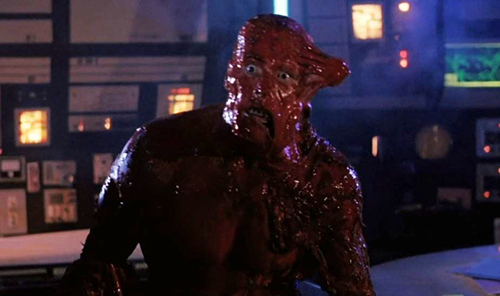
 All I recall about 1989’s The Terror Within is that I’ve seen it. Going into The Terror Within II, retention doesn’t matter, were you so worried. The opening titles fill in any narrative blanks with broad, questionably need-to-know strokes: Biological warfare beget an apocalypse and “grotesque genetic mutations.”
All I recall about 1989’s The Terror Within is that I’ve seen it. Going into The Terror Within II, retention doesn’t matter, were you so worried. The opening titles fill in any narrative blanks with broad, questionably need-to-know strokes: Biological warfare beget an apocalypse and “grotesque genetic mutations.”
Andrew Stevens (Munchie Strikes Back) isn’t one of those, but he’s back toplining as David — not to mention making his directorial debut and writing the screenplay. Roaming the post-apoc desert where everything, per all of Roger Corman’s Concorde Pictures, is uncomfortably too orangey, David and his glue-on beard spear a lizard for chow and communicate with his peeps back at Rocky Mountain Lab. There, scientists (including Stevens’ mom, Poseidon Adventure victim Stella) rush to formulate a vaccine to combat an unpredictable virus, but conspiracy-duped parents upend school board meetings they lack key ingredients David hopes to find. Until then, Full Metal Jacket’s R. Lee Ermey — and you’re not gonna believe this — shouts orders.
This being a Terror Within movie, there’s a terror, all right — but since it’s prowling the sands, it’s not yet within. It’s also not yet seen, depicted only by an arm swatting into frame and, for the rare POV shot, a completely blue screen. (Folks, in just three years’ time, cinematographer Janusz Kaminski would go from blue to black and white … and win the cinematography Oscar for Schindler’s List.)
Soon, David witnesses a young man and woman grappling with the creature. Following a fruitless attempt at subjugation by boomerang, the man dies, but David pledges to watch after the poor sap’s sister, Ariel (Clare Hoak, Cool World). Not even a day passes before Ariel thanks David with a guided tour of her uterus.
Ariel does not afford the terror within this same pleasure; it simply takes her from behind — but tastefully, y’know, because Stevens shows us just one thrust. Later, at the lab, when she’s scanned for pregnancy, we get a hilarious animation of a lone white sperm (David’s) peacefully flagellatin’ its way into her egg … momentarily followed by one black sperm (the terror’s), spikes and all, aggressively shoving in for sloppy seconds. The resulting infant is so hideous, not even principled YouTube influencers would hesitate to rehome it.
Somewhere between the crawling in the air ducts, the “Come to Papa!” quip and especially the reveal of the monster looking like a grown man dipped in marinara and sporting a head hernia, you realize you’re watching a simultaneous rip-off of Alien and Aliens … and then asking yourself, “Why?” —Rod Lott









